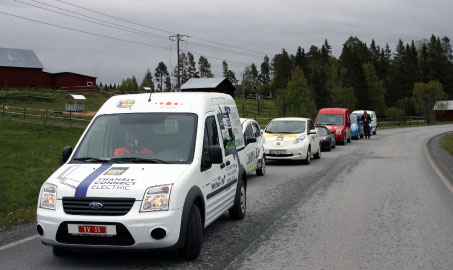
Avinor’s emphasis on ecological electricity-powered vehicles has even seen it take part in the Zero Rally 2012, a race for zero or low emissions cars. Trondheim Airport’s Environmental Adviser Grethe Fremo participated with Roy Sagen, a fire fighter from the airport’s location in Værnes, in the Airport Electrician’s electric car.
Designed to support the sustainable future growth of aviation and its airports, Airport Carbon Accreditation is testament to the industry’s commitment to limiting its impact on climate change. The programme facilitates the assessment and recognition of participating airports’ efforts to manage and reduce their CO2 emissions, as well as helping to deliver the financial benefits of heightened energy efficiency, and providing a vehicle for the development of best practice. As Airport Carbon Accreditation nears the end of its fourth year, 14 airports have been accorded its highest accolade, and are continuing to surpass their sustainability goals with ever more effective environmental initiatives. Airports that have achieved the Neutrality level of accreditation have demonstrated the highest commitment to carbon reduction, having fulfilled the requirements of the Mapping, Reduction, and Optimisation levels, and offsetting residual emissions from those sources over which it has direct control, using internationally recognised offsets.
Big steps in reducing the carbon footprint
With the accreditation of three of its airports, Norwegian operator Avinor has established that it is dedicated to limiting its carbon footprint, with its Oslo and Trondheim airports Airport Carbon Accredited at the Neutrality level, and Kristiansand Airport accredited at the Reduction level. “Of course, though safety is paramount, the environment is one of Avinor’s five top priorities,” explained Olav Mosvold Larsen, Senior Environmental Advisor, Avinor. “Our CEO Dag Falk-Petersen has signed an ambitious company environmental policy, and there is consensus in the top management and board that environmental issues, be it noise, carbon or other emissions, are potentially significant constraints for developing the industry, and that good environmental performance is advantageous to Avinor’s reputation.”
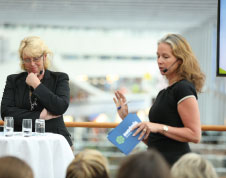
The Minister for Environment for Sweden Lena Ek and Swedavia’s Group CEO Torborg Chetkovich on the day that Swedavia achieved the Neutrality level of Airport Carbon Accreditation for all 10 of the airports in its network. Stockholm Arlanda Airport was the first in the world to be recognised at the programme’s highest level.
The importance of carbon neutrality to the industry’s progress and reputation has also been felt at Swedavia, where environmental issues have been taken into the governance of the company, together with social and economic concerns, and is considered in every part of its decision making. “Our work is aiming to create a license to fly, and thereby enabling the country to grow,” said Swedavia Group CEO Torborg Chetkovich. “Sweden as a country is far away from many of the world’s important markets and we are extremely dependent on building bridges and strengthening our bonds with the rest of the world, so, of course, we need to do everything we can to minimise the negative impact on the environment. We perceive it as an opportunity to grow the airline industry, rather than letting people use it as an excuse not to fly. In Sweden, industry is very important, and tourism is also booming, and if we can’t fly in and out of the country efficiently it will be very difficult for these sectors to develop.”
As well as strengthening air travel accessibility in Sweden, the operator’s carbon reduction efforts are setting an industry-leading example in addressing climate change. Stockholm Arlanda Airport was the first to reach the Neutrality level in 2009, and when Swedavia was created in 2010, it was able to learn from the experience and apply its expertise to its remaining nine airports – Göteborg-Landvetter, Bromma Stockholm, Malmö, Luleå, Umeå, Åre Östersund, Visby, Ronneby and Kiruna airports are all accredited at the Neutrality level. In seven years, Swedavia has reduced its carbon dioxide emissions by more than -60%. Its objective is now to achieve zero emissions across its airport network by 2020, and it is certainly on the right track – the operator has made significant advances in influencing change at its airports and beyond. As well as investing in heavy ground vehicles that run on renewable energies, since 2011, only taxis that run on biofuels are allowed to transport passengers to and from Stockholm Arlanda. “We have also announced a similar commitment at Stockholm Bromma Airport, so that’s an example of how our actions are making big changes – we have forced the big taxi companies in Stockholm to change to more environmentally effective fuels,” Chetkovich said.
Environmentally effective ground vehicles also play a large part in reducing Avinor’s CO2 emissions. Electric vehicles and bio-ethanol vehicles have been acquired at Oslo Airport, which is also embarking on an investigative project on the use of hydrogen in airport vehicles. At Trondheim Airport, Environmental Adviser Grethe Fremo, explained: “We have been working actively on reducing emissions from surface access to the airport. We are collaborating with bus companies and research institutes, and now demand that airport express coaches use bio-diesel. We also ran a programme termed ‘Use your own engine’, where prizes were awarded to employees who cycled, walked or ran to work. Trondheim Airport is part of the local Green Highway project too, and we have a fast electric vehicle recharger unit at the airport for passengers and other drivers.”
A clear-cut emission reducing strategy is also in place at SEA SpA, the developer and manager of Milan Malpensa and Milan Linate airports, both of which have obtained the Neutrality level of accreditation. “Since 1992 SEA has felt obliged to act in the field of rationalisation of energy consumption and the search for positive benefits for the environment, and in particular also in the field of CO2 emissions,” explained Dr. Giovanni Falsina, SEA’s Environment and Airport Safety Manager. “In 1998 the new airport of Milan Malpensa was inaugurated and in later years, after the entry into force of Emissions Trading Directive, numerous interventions were carried out for gradually abandoning the energy production facilities existing in the Terminals 1 and 2 of Malpensa Airport. Our company designed and built – with other institutional shareholders – an independent entity, SEA Energia, with the aim of producing and selling energy to the market, and, of course, being the main energy supplier of the two SEA airports, Milan Linate and Milan Malpensa. SEA believes that certification by Airport Carbon Accreditation is very important to confirm its historical airport commitment on the theme of climate change.”
SEA’s Environmental Management System (EMS) has been designed to efficiently handle all of the operator’s energy saving measures, and relies on the orientation of all airport stakeholders towards a responsible commitment to the environment in which they operate. The EMS considers every aspect of airport environmental responsibility, from CO2 emissions, noise and air pollution, and energy management, to water management, waste, light pollution, and the airport’s effect on the landscape. All new facilities, and the future of SEA’s infrastructure, will be influenced by its energy-saving criteria.
Airport-wide initiatives
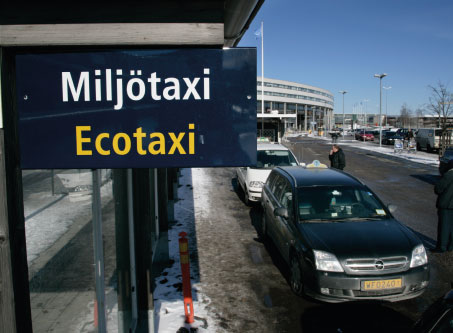
Since 2011, only taxis running on biofuels have been allowed to enter Swedavia’s Stockholm Arlanda Airport, and it was recently announced that the same policy would be applied to Stockholm’s second airport, Bromma – an example of how Swedavia is instigating change not just airport-wide, but nationwide.
An airport is an ideal environment for the development of new and resourceful innovations in emission reduction and energy efficiency, and across its network Avinor has developed a range of solutions. At Oslo Airport there is a continuous focus on energy efficiency investment, with the reconstruction of heat recovery in ventilation, the reconstruction of light armatures, and the mounting of LED-spotlights at aircraft parking all playing their part in the airport’s attainment of carbon neutrality. Several inventive implementations at Oslo Airport are reducing energy consumption too, where an ingenious snow storage system will act as a cooling source for ventilation during the summer.
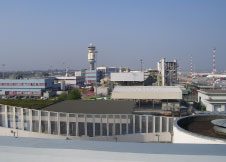
SEA Energia was founded in 1992 to produce and sell energy, and is the main energy supplier of SEA Airports (for a particularly competitive pricing and a reliable power supply). SEA promotes and manages all the actions of saving and rationalisation of energy consumption in its airport infrastructure.
“The energy centre at Oslo Airport consists of a district heating plant, a district cooling plant and a ground water heat exchange system. The district heating plant provides heating for buildings in winter, while the cooling plant provides cooling for buildings in summer. The groundwater heat exchange system extracts heat from Oslo Airport’s buildings in summer and stores it for use underground in winter,” explained Hege Ringnes, Oslo Airport’s Environmental Adviser. “There is a terminal expansion ongoing at Terminal 2, and the new terminal is very energy efficient compared to the old terminal built in the 1990s. The demand for energy consumption is half that of the existing terminal building.”
Throughout SEA’s airport operations, a range of successful initiatives have been implemented for effective energy management, including different levels of terminal conditioning; the introduction of low-consumption lamps; the replacement of the lighting towers on the Malpensa Airport apron; and the renewal of shuttle bus services in Linate and Malpensa, and SEA is now investigating responsible sources of energy.
As well as launching its Energy Saving campaign for the education of staff and customers on the use of energy and respect for the environment, it has also greatly increased its emphasis on the issue of renewable resources. “SEA is designing a new project related to a biomass plant in Malpensa and, in Linate, it is investigating the possibilities of using the artificial lake Idroscalo, adjacent to the airport area, to install a heat pump,” explained Falsina.
At Swedavia, energy efficiency is a perfect example of its airports’ endeavors to reduce emissions, and at the same time strengthen their competiveness and the conditions for connectivity. Since 2005, energy consumption has been reduced by -20%, and its aim is to further reductions by -2% every year. Its Swedavia Energy sector has lead the way in this development, while much of its success comes down to the fact that it has put energy efficiency high up on the agenda in all of its departments as well as amongst its stakeholders.
Collaboration with airlines
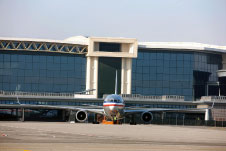
Throughout SEA’s airport operations, a range of successful initiatives have been implemented for effective energy management, including different levels of the terminal conditioning; the introduction of low-consumption lamps; the replacement of the lighting towers on the Malpensa Airport apron; and the renewal of shuttle bus services in Linate and Malpensa.
Key to the success of airport carbon neutrality is the collaboration between operators and their third party stakeholders, and increasingly airports and airlines are joining forces as allies in the battle against climate change.
As the airport operator of a small country with three main airlines (network operator SAS; low cost carrier Norwegian; and regional airline Widerøe), where it serves as both operator and ANSP, Avinor operates in a landscape well suited to collaboration. “With regards to environment, collaboration has been very good over the last six to seven years,” said Mosvold Larsen. “We have been joking and terming it ‘Coopetition’ – a combination of cooperation and competition. Airlines are fierce competitors on a daily basis, but manage to cooperate well to improve the environmental performance of the Norwegian aviation industry. The latest addition to the collaboration is a comprehensive project on biofuels for aviation published this spring. Following up a report from the project, Avinor has committed to invest up to €13 million over the next 10 years to promote production of aviation biofuels in Norway.”
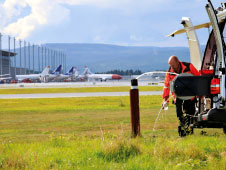
Trondheim Airport’s Environmental Adviser Grethe Fremo: “We have been working actively in reducing emissions from surface access to the airport. We are collaborating with bus companies and research institutes, and now demand that airport express coaches use bio-diesel.”
In Sweden too, airlines are working alongside Swedavia’s airports to further the impact of its environmental actions. “Several of our airlines have ordered new aircraft that will start to enter the Swedish market from this year onwards,” Chetkovich said. “The new aircraft will be less noisy, we are talking about a reduction of -20-25%, and they use fuel in a more efficient way – also around -20-25%.” Chetkovich also hopes that Swedavia’s commitment to carbon neutrality will spread from the nation to around the world, with airlines using Swedavia as a benchmark to influence other airports’ emission reducing initiatives.
“We still have many steps to take. It’s an ongoing work and we must be successful to enable long-term growth and secure all the benefits of air travel. Otherwise, sooner or later, we will reach a point where this growth is unwanted. And we really cannot do without flying. It brings us closer and creates social and economic opportunities throughout the world,” said Chetkovich. “In many areas, such as more effective air traffic management and renewable jet fuel, we can see the development coming. As an airport group our responsibility lies in making this development possible as quickly as possible. At the same time we already feel that investments in new aircraft among airlines has significant public support – and when combining new techniques, new aircraft and better public transportation, the industry is really on the right track in delivering on demands upon a more sustainable transport sector.”
The final results of the CO2 reduction achieved for Year 4 of Airport Carbon Accreditation will be announced at the 22nd ACI EUROPE & ACI World Annual Congress in Istanbul, 10-12 June 2013.







